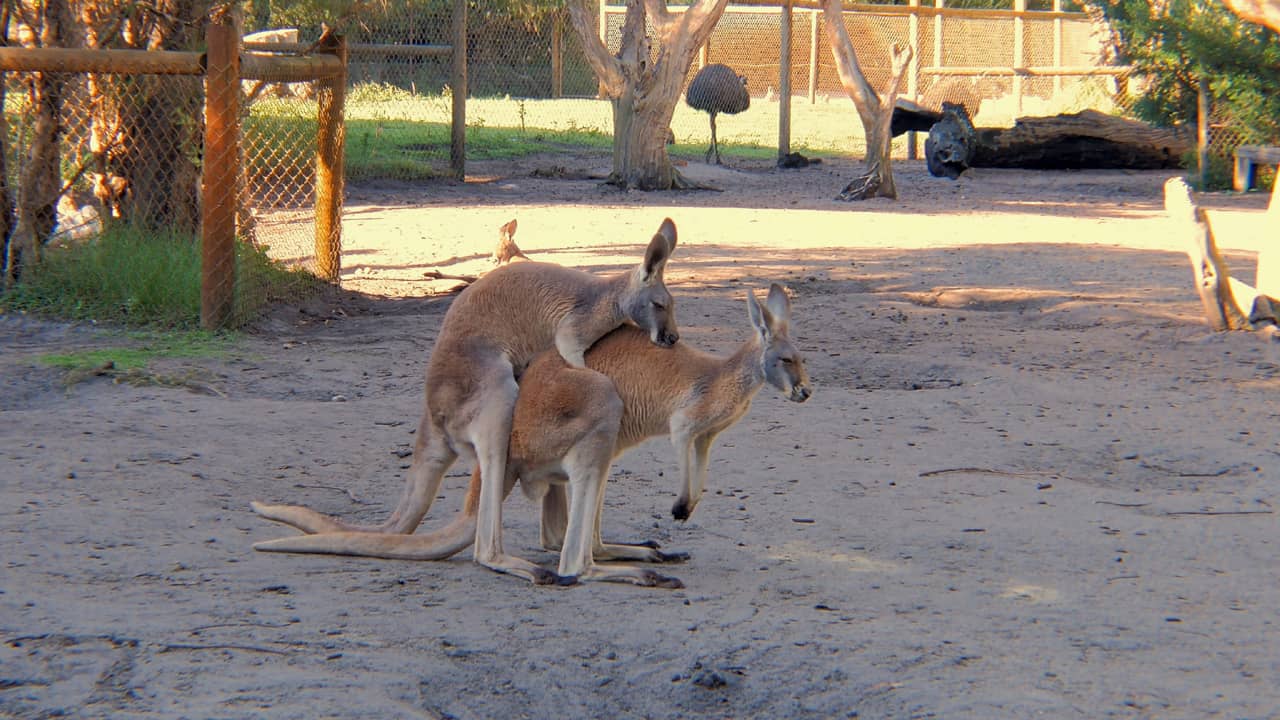Red Kangaroo Reproduction area Caversham wildlife Australia
Loading Video...
Red Kangaroo Reproduction Area Caversham Wildlife Park Australia
The red kangaroo – Macropus rufus is the largest of all kangaroos, the largest terrestrial mammal native to Australia, and the largest extant marsupial. It is found across mainland Australia, avoiding only the more fertile areas in the south, the east coast, and the northern rain-forests.
About Red Kangaroo
This species is a very large kangaroo with long, pointed ears and a squared-off muzzle. They are sexually dimorphic as the males have short, red-brown fur, fading to pale buff below and on the limbs. Females are smaller than males and are blue-grey with a brown tinge, pale grey below, although arid zone females are coloured more like males. It has two forelimbs with small claws, two muscular hind-limbs, which are used for jumping, and a strong tail which is often used to create a tripod when standing upright. The red kangaroo’s legs work much like a rubber band, with the Achilles tendon stretching as the animal comes down, then releasing its energy to propel the animal up and forward, enabling the characteristic bouncing locomotion. The males can cover 8–9 m in one leap while reaching heights of 1.8–3 m, though the average is 1.2–1.9 m.
Red Kangaroo Reproduction Area Caversham Wildlife Park Australia
Red Kangaroo reproduction
is truly fascinating. Kangaroo females get pregnant in a regular way. They shed an egg from their ovary and it drifts down the fallopian tube where, if it meets up with sperm, the egg is fertilized and then embeds itself in the wall of its mother’s uterus. The big difference between us regular mammals and marsupial mammals, no placental connection is formed. As soon as the marsupial egg has consumed its own yolk to stay alive and develop just like a bird egg, it has to be born. So the whole pregnancy is only about 28 days long.
At the end of the pregnancy, the expectant mother takes up a sitting position and grooms her pouch. The baby emerges from an opening at the base of her tail called the cloaca. The infant is very tiny, only about the size of a lima bean. It’s pink and largely undeveloped except for its two front arms that are crucial for its climb up its mother’s abdomen to the pouch. The baby, which is little more than a fetus, makes this climb completely unaided and guided only by instinct. Once inside the pouch, the baby finds one of its mother’s four nipples and takes the end of one in its mouth. The baby doesn’t have the muscles to suck at this stage. Instead, the nipple swells inside the baby’s mouth so that it can’t disengage and milk is secreted very slowly into its mouth. Later, once the baby’s jaw is more developed, it will be able to disengage and suck at will.
Once mum has given birth, she will mate again and become pregnant only this second baby won’t be born after 28 days like the first one. Instead, the second baby develops until it is a bundle of around 100 cells and then stops growing. It just sits there and waits for the tenant in the pouch to vacate. This ability to suspend a pregnancy is called embryonic diapause and almost all kangaroos and wallabies are capable of it. The advantage of this is that mum can replace a joey very quickly if she loses one.
About Caversham Wildlife Park
David and Pat own and operate Caversham Wildlife Park with their son David & daughter Debbie.
When they purchased the park in 1988, the park housed a small collection of animals and birds on a modest 5 acre (2ha) property. A few years later, the park doubled in size, when the family purchased the adjoining property and the collection started to boom. In May 2003, the family designed and built a new park in Whiteman Park, once again, more than doubling in size.
Opening Hours of Caversham Wildlife Park
Caversham Wildlife Park is open 9.00am to 5.30pm every day of the year except Christmas day (December 25).
Last entry into the park is at 4.30pm.
We recommend you arrive before 3.00pm if you wish to see and do everything (some attractions start to close from 3.00pm).
To make the most of your visit and enjoy all of the attractions, we recommend you allow at least 3 hours in the park.
Monday 9.00am – 5.30pm
Tuesday 9.00am – 5.30pm
Wednesday 9.00am – 5.30pm
Thursday 9.00am – 5.30pm
Friday 9.00am – 5.30pm
Saturday 9.00am – 5.30pm
Sunday 9.00am to 5.30pm
Come and spend the day at one of Perth’s most exciting tourist attractions, showcasing the largest private collection of native wildlife in Western Australia.
Hand-feed the kangaroos, join in the interactive farm show, touch a possum or lizard, meet a wombat, watch the cheeky penguins being fed, and have photos taken with koalas! Caversham Wildlife Park; a great Australian meet & greet experience for the whole family, in one fantastic day!
All of our shows, interactive experiences, photo opportunities and animal food are included in the entry fee! With no extra money needed around the park, you can make the most of your experience at Caversham Wildlife Park.
Caversham Wildlife Park is very proudly owned and operated by a Western Australian family. We don’t receive any Government assistance; the park is solely funded by visiting patrons! Thank you for your support and assistance!

0 Comments Be First to Comment